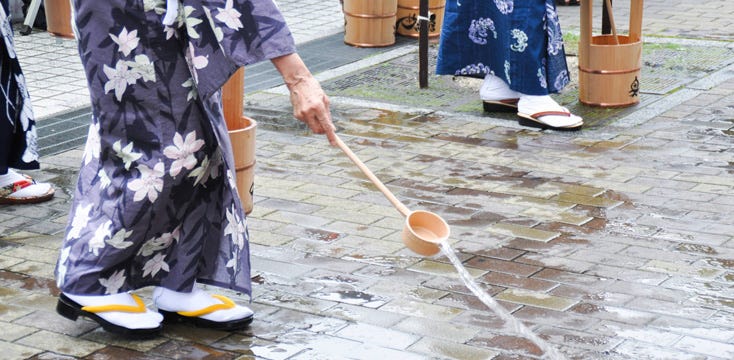July 7 - 11
温風至
あつかぜ いたる
Atsukaze itaru
”Warming winds blow”
Kō 31 marks the beginning of the sekki Shōsho (小暑, lit. “the small heat”), which then leads into Taisho (大暑, lit. “the big heat”).1 It’s only appropriate, then, that the first microseasons leading into this time of rising summer temperatures highlights that everpresent touch of nature you can experience without even needing to look for it: the wind.
Since the concept of “warm weather” is not exactly unique to Japan, rather than explain it I thought it’d be interesting to look back at some ways Japanese people over the centuries have felt about summer, and how they beat the heat.2 Let’s start with an illustration by the wonderful Sayuri Sasai, who creates comics and infographics about Edo-period Japan that are bursting with the lively charm of the everyday.
The main image depicts a scene where two women attempt to cool off inside with a recent purchase: a hand-cranked fan.3 These were around from the early 1800s, until the electric motor began making its way around the world. They sit in a tatami mat room with reed screens covering open doorways. Traditional Japanese homes were designed to be fully opened from different sides, their floor-to-ceiling sliding doors allowing for easy adjustments to catch cross-breezes.
Sasai’s comic also depicts a common technique for cooling off a home: scattering well-drawn water on the ground in the morning and evening. As a form of early air-conditioning it worked surprisingly well, and there are people and places that still do it as a form of energy-saving passive cooling.
Once sat inside with as much shade and breeze as you could muster, there’s a variety of treats that can help you cool off (or at least feel cooler). The most enduringly popular, which stands even today as a classic symbol of summer, is the suika—watermelon in English. Sprinkled with a bit of salt, it’s a perfect snack for prevention of heat exhaustion. Salt for better retention of moisture, and sugar for energy!
A uniquely Japanese option is anmitsu (餡蜜), a traditional sweet made up of anko beans, fruit slices, jelly cubes4, sweet dumplings, and syrup. The red-and-white snack in the comic above is an early, simpler precursor: hiya-mizu (冷や水, “cooling off water”), which was just sugar-sweetened water and dumplings. Gradually, as more types of ingredients became more available, the base was built upon, and there are many types of anmitsu to be enjoyed in the summer (or winter!)
Perhaps paradoxically, hot drinks are also a good option for the summer. A popular choice during the Edo period was amazake (甘酒), a sweet fermented rice drink similar to saké but low- or non-alcoholic. There’s decent evidence backing this up, too: hot drinks on a hot day make you sweat more, and that sweat carries heat off your skin when it evaporates.
But there is nothing quite as welcome on a hot day as a cool breeze to freshen the air, and Japan has long appreciated that unseen sensation via a traditional wind chime called a fūrin (風鈴, lit. “wind bell”). First coming to popularity over 2,000 years ago, these colorful decorations can be found in many Japanese homes today, and are a sure sign of the season.5 Even though they don’t cool you down directly, the pleasant sound of one stirred in the wind breaks up the heavy, humid air.

These days, there are a large variety of modern atsusa-taisaku (暑さ対策, “heat countermeasures”) items out there, although they mostly fall into the realm of chindōgu (珍道具, “gadgets suited only to a specific purpose”). Alongside the types of tiny electric fans you might expect, there are specially formulated cooling wipes, neck coolers, pillow covers, vests with inbuilt fans, and innumerable drinks and drink-adjacent jelly pouches all hoping to help you stave off necchūshō (熱中症, heatstroke). Japan has yet to encounter a problem it can’t try to creatively invent its way out of.



A survey of 13,000 Japanese people aged 10-60 found that their Top 5 products for surviving summer were: cooling neck towels (冷感タオル, reikan taoru), sodium intake candies (塩分摂取飴 enbun sesshu ame), the humble hat (帽子), the simple hand fan (うちわ, uchiwa), and electrolyte hydration drinks (経口補水液, keikō hosui eki), like Pocari Sweat and Aquarius.
At the end of a long, hot summer’s day, when the scorching sun is finally set, the best way to recover all that lost energy and stamina is with something tasty and in-season (provided you didn’t spend the whole day snacking on watermelon).
● Seasonal vegetable
gōya, ゴーヤ, bitter gourd● Seasonal seafood
kochi, こち, tentacled flathead● Seasonal flower
sarusuberi, 百日紅6, crape myrtle



The rainy season may be ending, but it leaves behind a heavy moisture in the air which can lead to sudden thunderstorms, sometimes the most dangerous and deadly of the year. All the more reasons to seek shelter somewhere cool and dry until things pass.
See you next kō~
[Images & info by kurashikata.com, kurashi-no-hotorisya.jp, 543life.com, and Wikipedia except where otherwise noted]
We’ll see these again in January with “the small cold” and “the big cold”
Although the basics still hold true: drink more than you think you need, keep up your salts, and take time to rest and cool down if you feel overheated!
The woman turning it is saying “Check out what I bought! Waddya think??” to which her sister replies “So cool! But you seem hot…”
Usually agar
These types of items which are strongly tied to a specific season are called fūbutsushi (風物詩)
The kanji characters for this flower literally mean “100 days of red” and refer to how the flower sticks around until autumn










I shall now call them "wind bells," which sounds much better. How did you know I've been snacking on watermelon all day? Stay cool :)